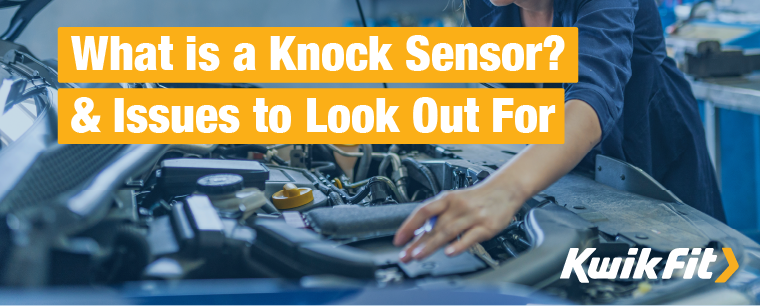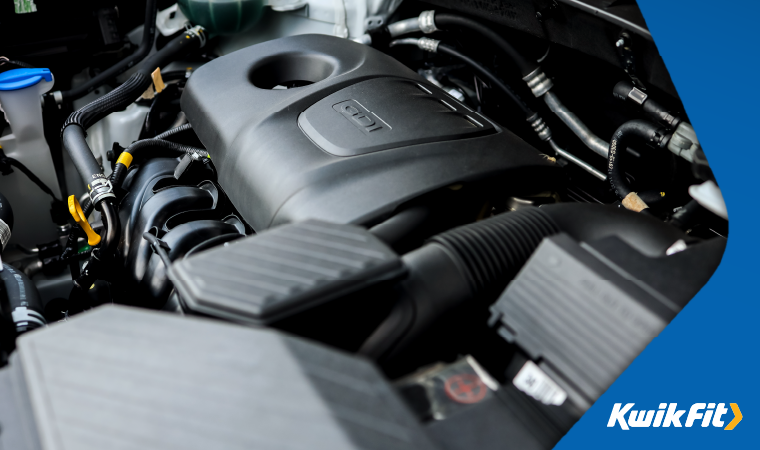What is a Knock Sensor? & Issues to Look Out For
Jack Dreyer | Monday 15th January 2024 11:00am

For many drivers, what goes on under their cars’ bonnets is a mystery — and they’re happy for it to stay that way. Others, on the other hand, are eager to get to grips with the functionality and purpose of every nut and bolt they see.
Car enthusiasts, we salute you.
We encourage everyone to get curious about the parts of their vehicle, especially when they start making funny noises or throwing up warning signs. That’s why we try to cover things in as much detail as possible here on the Kwik Fit blog. On today’s agenda? The humble knock sensor, a crucial detector of potential vibration-induced damage in vehicles.
Whether you’ve come across this particular car part before, or are just interested in expanding your knowledge of all things under the bonnet, read on to get acquainted with knock sensors.
What is a knock sensor?
Knock sensors are small devices that are used in internal combustion engines (the regular engines that petrol and diesel cars have). Their purpose is to detect any vibrations and send a signal to the engine control model (ECM) in order to prevent engine knock. Let’s define engine knock quickly, too, before we move on.
Engine knock
“Knocking” in the engine often occurs when fuel burns unevenly in the engine’s cylinders. Occasionally, the balance of air and fuel in an engine cylinder is incorrect and can cause the fuel to burn in small pockets, rather than evenly all at once.
This process occurs rather like a chain reaction, where the ‘aftershock’ from each pocket burning ignites the next pocket in a cycle. These irregular shocks are what cause engine knocking — an annoying noise, and a potentially damaging phenomenon to your cylinder walls and pistons.
What causes engine knocking?
But why is the balance of fuel and air sometimes incorrect in the first place? What actually causes engine knocking? There are three possible causes.

1.) Faulty spark plugs
If your spark plugs haven’t been replaced recently, or have worn out altogether, they may well be contributing to the issue. Spark plugs are responsible for delivering the electric spark that ignites the mixture of fuel and air itself. So, if these are broken or only working partially, there’s no doubt that this mixture will be burning irregularly and causing knocks.
2.) Deposits of carbon
Usually, fuel should include carbon cleaning detergents to help reduce the likelihood of carbon deposits clogging up engine cylinders. But this isnt always the case, and deposits of carbon can, and do, build up.
When this happens, there is less space for the fuel and air mixture to sit, leading to increased compression and a nasty knocking noise.
3.) Low-octane fuel
Every different type of fuel has a different octane rating. Notice the different options available when you go to fill up your car? These are the fuels with the most common octane ratings.
If you have consistently been using the wrong fuel — or fuel with a very low octane rating — that may well be the reason behind your engine knocking (and decreased fuel economy). So, check the vehicle handbook for your vehicle to decipher what the suggested octane rating is for your fuel type and, if possible, use that. If your engine was designed for high-octane rating fuel, consistently using a lower form may be causing issues.
Usually, fuels with lower octane ratings are cheaper. However, the long-term benefits greatly outweigh the immediate costs when you consider engine health, performance, and maintenance here.
Why are knock sensors important?
Knock sensors are crucial to vehicles as they help maintain engine performance and promote engine longevity. And without an engine? No car.
These sensors can be found on the outside of the engine block or cylinder head to effectively monitor vibrations and knocking noises in all engine operating states. By being positioned on the slide of the engine block, the knock sensor can “listen” for any structure-borne vibrations from the block, and convert them into electrical signals.

How do knock sensors work?
A form of piezoelectric sensor, knock sensors have an intricate design to ensure they are as responsive as possible to any vibrations present. If a knock (or vibration) is detected, the sensor then sends an immediate electronic signal to the ECM which, in turn, adjusts the ignition timing to prevent further knocks from occurring.
How the ECM does this is a very intricate process. But, putting it simply, the ECM relies on a microprocessor and a handful of algorithms to double-check that the sensor signal is actually a knock before adjusting the ignition timing.
The knock sensor doesn’t work alone in feeding the ECM with information, however. In fact, the throttle position sensor, oxygen sensor, and MAF (Mass Airflow Sensor) also give the ECM valuable insights into the performance of the car.
How to spot a faulty knock sensor
When a vehicle’s knock sensor isn’t functioning as it should, it is usually indicated by the following series of issues.
1.) Poorer engine performance
In most cases, having a faulty knock sensor has a knock-on effect (pun intended) on the day-to-day running of the engine. Engines with malfunctioning knock sensors tend to lack power and acceleration capabilities. Why? Because, in the absence of a sensor, the engine will likely be running with inefficient ignition timing, thus decreasing its performance.
2.) Lower fuel efficiency
If the sensor isn’t operating properly — and therefore not telling the ECM to sort out the ignition timing — it is likely that fuel consumption will increase. The engine may well be consuming more fuel than usual, trying to start, reducing fuel efficiency significantly.

3.) Engine start difficulties
If the ignition timing is off, you may encounter difficulties when it comes to starting your car — as the engine struggles to start. This is down to the ECM’s inability to adjust the ignition timing, since no helpful signals from the sensor are being sent.
4.) Warning lights
Lastly, if there’s an issue with the knock sensor, this will often manifest in the form of an engine dashboard light coming on. More often than not, this takes the form of the ‘Check Engine Light’.
That being said, a faulty knock sensor is not the only thing that is capable of causing these problems. All of the examples above can be signs of more serious underlying issues with your vehicle. So, just to be sure, we recommend getting a diagnosis from a professional at your nearest Kwik Fit Plus centre.
What to do if your knock sensor is faulty
If you suspect that you may have a faulty knock sensor, the best thing to do is pursue diagnostic testing in good time.
Electronic diagnosis
One of the common methods for diagnosis is to use a scanner or code reader to check for trouble codes relating to the knock sensor that may be preventing accurate, timely signals from being sent. A diagnostic scanner can be connected to your vehicle's OBD (or onboard diagnostic) port to show the codes stored in the ECM.
Visual inspection
Alternatively, a visual inspection of the knock sensor could be performed to determine whether it is faulty — and why. This involves a thorough check of the sensor to look for physical damage like cracks, debris, or wear and tear. An inspection of the wiring connected to the sensor should be checked for issues too.
Of course, this needs to be carried out by a professional who knows how to safely access and inspect the knock sensor without risking damaging any other nearby parts.
Visit a Kwik Fit Plus Centre
If you have ongoing issues with your knock sensor, we strongly recommend bringing your vehicle into one of our Kwik Fit Plus centres. Here, our team of experts can investigate, diagnose, and resolve the issue for you while you wait.
Our Kwik Fit Plus centres offer advanced vehicle repairs above and beyond our regular fast-fit products and services, allowing us to handle: timing belt changes, electrical faults and repairs, ignition system problems, vehicle sensor issues, and more.
Interested in learning more about your vehicle and its innerworkings? Keep up with the Kwik Fit blog. Or, if you’ve got any specific questions, get in touch with us today.
Any facts, figures and prices shown in our blog articles are correct at time of publication.
Featured Articles
Is it Illegal to Drive With One Headlight?
Saturday 19th July 2025
Wondering if it’s illegal to drive with one headlight? Learn about the safety risks and penalties of illegal blown bulbs and why you should fix them promptly.
Air Con in EVs & Hybrids: Experts Answer Your Questions
Monday 30th June 2025
Does air con drain EV batteries? Can you use the air con while charging an electric car? Find out the answers to these questions & more from Kwik Fit’s experts.
Why Is Your Car Making a Noise? Fixes & Tips
Friday 13th June 2025
When your car starts making unexpected noises, it can certainly be quite disconcerting; it may be nothing to worry about, but here’s what you need to know.









